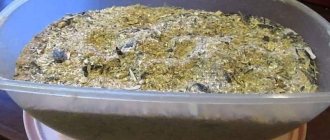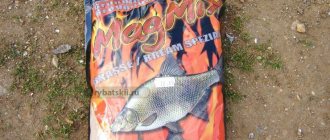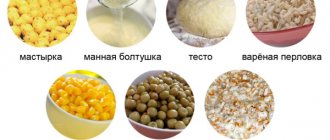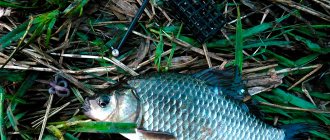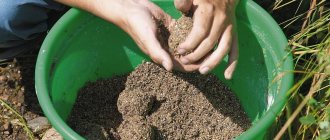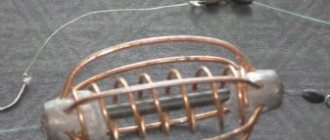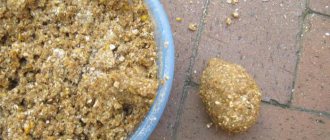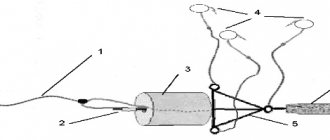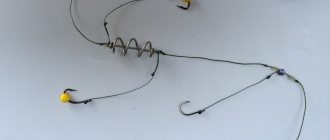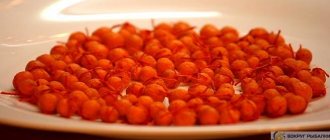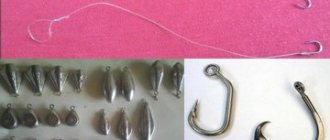To catch peaceful fish species, you need a food mixture that can gather a large school in a limited area. Without this, counting on a good catch of crucian carp is futile. Even if the hunt is not for trophy fish, but for small baitfish. The best bait for crucian carp is selected taking into account the characteristics of the reservoir and the time of year.
Preparation of bait should be carried out in accordance with the natural preferences of the fish. The diet of crucian carp may differ significantly. It all depends on the age of the fish, its habitat and the time of year. Local fishermen actively use bait for crucian carp, accustoming them to the same porridges.
- The fry feed on the smallest microorganisms that live in the reservoir. At one month of age, the diet of small fish consists of insect larvae, bloodworms, daphnia and crustaceans. After reaching one year of age, crucian carp feed on larvae, small crustaceans and annelids.
- Large individuals add more substantial food items to the above dishes. These can be earthworms, leeches, shells. From a young age, fishermen in many reservoirs have accustomed crucian carp to certain plant components. These include bread crumb, various cereals, dough, etc. Fish often approaches those points where the bait is flavored.
The diet of crucian carp also depends on the time of year. Since fish are most often at rest in winter, two main periods should be distinguished.
- Early spring and late autumn are characterized by low water temperatures. In such conditions, the fish becomes inactive, and it prefers to eat high-calorie animal food. The bait should contain few saturating ingredients. A minimum of bait is added to the fine-grained base to attract sedentary fish.
- From late spring to mid-autumn, crucian carp actively feeds. Digestion occurs quite quickly in warm water. Therefore, you should not be afraid to overfeed fish in a large body of water. It is necessary to add boiled cereals, plant and animal baits to the dusting components. Odorous additives allow you to achieve a high concentration of fish on a baited spot.
Groundbait components
The basic composition of bait for crucian carp is in many ways similar to mixtures for other peaceful fish species. Both store-bought food and homemade food should consist of a base and additional components.
As a working feed base, you can use crushed ingredients such as millet, corn, pea, barley and oat flakes.
You can use a store-bought base mixture to which special ingredients are added. The following products create an attractive aroma in water for crucian carp:
- vanilla;
- anise;
- caramel;
- dill;
- garlic;
- chocolate.
During the cold season, flavorings for crucian carp fishing are introduced in small quantities. Attractants, worms, etc. work best.
Other fillers will be required during the cooking process. Dry breadcrumbs are often added to increase the volume of bait. They create a trail of haze and a pleasant aroma.
Photo 1. Feeding components.
The most important ingredient that attracts crucian carp is sunflower cake. Some fishermen purchase the valuable product in layers, adding it to the homemade composition in small portions.
To give the finished bait the required consistency and color, different types of soil are used. Sand is added to quickly break up the lump at the bottom. It makes the feed mixture light. To slow down the process of disintegration of the bait ball, crushed clay is added. If the bottom of the reservoir is dark, then it is worth introducing lowland peat into the mixture.
Flavors. What it is?
Flavorings for fishing are a large group of substances that can be divided into:
- for nozzle;
- for bait.
These substances are used as seasonings. They make the taste of baits and baits for crucian carp much more tempting. After all, this fish relies more on smell than on sight when looking for food.
Some experts argue that the sense of smell of fish, including crucian carp, is much more developed than that of mammals.
It's worth knowing that flavorings are not some kind of "magic pill." They just act as an attracting factor. They should be selected correctly.
If we compare flavorings with attractants, then the latter just simply interest the crucian carp. In this case, the fish does not necessarily have to bite, because attractants have absolutely no effect on appetite.
There is also a slight difference between flavoring agents and activators. Unlike a bite activator for crucian carp, flavorings attract fish until the very end of fishing.
Store-bought bait versus homemade porridge
Anglers specializing in crucian carp fishing often argue about the origin of the feed mixture. Some people find it easier to work with dry ingredients, while others prefer to cook porridge according to an old recipe. Each type of bait has its own advantages and disadvantages.
Advice! When choosing a bait mixture, you should take into account the characteristics of the reservoir. When going to an unfamiliar pond or lake, it is useful to ask experienced fishermen about the preferences of crucian carp.
Store-bought formulations are considered universal bait that can be taken to any body of water.
- The developed recipe is often based on the experience of famous fishermen and ichthyologists. The composition contains all the important components for luring crucian carp.
- Dry mixtures are easy to use, moistening occurs within 15-20 minutes, you can mix any amount.
- The use of the finished product allows you to create an attractive spot, both horizontally and vertically.
Photo 2. Option of ready-made bait.
However, industrial formulations are not able to take into account the eating habits of crucian carp, which have been developed over decades. This picture is observed in small reservoirs located near villages and villages. In these ponds and lakes, homemade bait for crucian carp comes to the aid of the angler. Somewhere the fish are accustomed to millet, in other regions they love corn. Often, villagers use feed that is intended for livestock. As a result, well-equipped townspeople with expensive fishing rods and bait watch with annoyance as local fishermen drag excellent crucian carp with enviable consistency on rough gear.
Store-bought bait or do it yourself
If you take bait from the store, then in the spring it is better to buy ground bait for cold water, or crushed feeder bait with a slight odorous aroma. Although, as mentioned above, complementary feeding does not always work properly in the spring. For example, cast into windows under the reeds using a bait of crushed worms or bloodworms, softening them in soaked bread.
The main thing is not to overdo it with bait and be sure to add a small amount of animal ingredients to the “mix” - maggots or bloodworms, which crucian carp really love.
On unfamiliar bodies of water, it is preferable to take a neutral position and use store-bought complementary food for cold water, with the addition of bloodworms, worms or maggots. And in early spring it is better to feed with small balls made from soil with particles of maggots and bloodworms.
Features of bait compositions by season
For each season, you need to select the most optimal feed composition. A store-bought mixture that does not take into account the seasonal preferences of the fish cannot always help out. The good thing about do-it-yourself bait for crucian carp is that it allows you to combine the composition even depending on the weather.
Spring bait options
If you didn’t have time to bring dry bait to the fishing store, then you can prepare one of the proven options yourself. Since the water did not have time to warm up in the spring, the easiest way to attract fish is with animal ingredients.
Summer feed compositions
In warm water, crucian carp's appetite becomes excellent. Vegetable high-calorie mixtures are replacing depleted baits. A special role is given to flavorings for crucian carp.
The simplest dry composition can be made from the following ingredients:
- crushed roasted sunflower seeds - 100 g;
- oat flakes - 100 g;
- breadcrumbs - 100 g;
- milk powder - 100 g;
- food for aquarium fish - 10 g;
- sugar - 3 g;
- vanilla - 1 g.
At the pond, the bait is moistened and clay is added to it.
On a note! The more clay is added to the bait, the denser the ball will be.
It’s enough to simply make bait from sunflower cake. To do this, take a piece of fresh cake and rub it with vanilla. It is then moistened and sprinkled with breadcrumbs. Large pieces are thrown to the fishing point, where they will gradually swell, attracting crucian carp with the aroma. Instead of vanillin, you can use flavors such as garlic, cumin, dill and anise.
Autumn mixtures
The bait for catching crucian carp in the fall must contain protein components. But flavorings are added in minimal quantities.
- Groundbait based on ground crackers and crushed roasted sunflower seeds works effectively in early autumn. Aquarium fish food and bloodworms are added to the mixture. At the tip of a knife, you can add vanillin to the bait. To achieve the required viscosity, the feed mass is mixed with the soil and moistened.
- To catch crucian carp in late autumn, bait is made based on crushed sunflower cake and dry daphnia. At the reservoir, you should scoop up a few small shells with a net, which are crushed and added to the composition.
Many bait recipes have been invented for catching crucian carp. Each of them can show their best side if the angler makes the necessary adjustments related to the characteristics of the reservoir and the time of year.
How to make bait for crucian carp
Crucian carp is distributed in all reservoirs and rivers in Russia. Catching it is very exciting and interesting. If you manage to lure this fish, the catch will be significant, and naturally positive impressions from fishing will bring complete relaxation with a feeling of complete satisfaction from the fishing process. In preparation for fishing for crucian carp
, it is necessary to take into account that this fish is lazy and sluggish, feeds mainly on algae and mud and is never hungry. But the taste and sense of smell of this fish are very well developed; it can hear attractive smells very far away, even in stagnant water. The more attractive the bait is for crucian carp, the more exciting the fishing will be.
Currently, in the network of fishing stores there is a large selection of dry bait, which costs a lot of money. And as practice shows, such bait is not always effective; we spend our money, but in the end we are left without a catch. It’s doubly offensive when your neighbor is biting.
I propose to consider several fishing recipes for preparing bait for crucian carp
.
The first bait recipe for crucian carp
Ingredients: bread crumbs, ground flour and cookies, steamed wheat and semolina. Mix all this, one measure of crackers, wheat and semolina, half a measure of flour and cookies, now add flavoring, garlic is very good, also vanilla, cinnamon, ground dill seeds, cocoa. Mix everything again, the smell of the flavoring should be slightly perceptible. On the shore, we bring the bait for crucian carp to its final state; if necessary, we add river water if we are fishing on a river with a current and, for example, we need to add soil from the river bank to the feeder tackle in minimal quantities, since this will make the bait loose and the current will wash it quickly. If we fish a body of standing water with a fishing rod, then we add soil, bringing the bait balls to a state in which, when they hit the water, they will not immediately crumble, but fall to the bottom and crumble evenly there.
Recipe two
Ingredients: pearl barley, peas and millet. Boil one measure of barley and a quarter measure of peas for about two hours, at the end add one measure of millet, cook for another 15 minutes. Then let it sit for several hours (until it cools down). Drain the water as much as possible, you get a homogeneous sticky mixture, and add flavorings - flax oil or hemp oil, and also add six to eight drops of anise oil. Mix it all. On the shore of the reservoir, we bring the resulting porridge to the required density using coastal soil. The bait for crucian carp can be used both on a river with a current, as well as on a reservoir with standing water.
DIY bait for crucian carp
The third bait recipe
Ingredients: breadcrumbs, bran and roasted, crushed sunflower seeds. Mix all this thoroughly, add three tablespoons of sugar or one teaspoon of honey per kilogram of mixture. Add flavorings, coastal soil and reservoir water, mix, leave, let it sit for about half an hour. This bait can be prepared directly on the shore.
Bait for crucian carp, recipe No. 4
Ingredients: wheat, corn and barley cereals, corn flour, semolina and ground flour. One measure each of wheat and barley grits, half a measure of corn grits, and a quarter measure of corn flour, semolina and flour. Sprinkle the dry mixture into bags weighing up to two kilograms. Having arrived at the fishing spot, add river water and a few drops of Corvalol (at the rate of six drops per kilo) to the dry mixture.
Well, if you need to quickly prepare bait for crucian carp, you can use the advice of experienced fisherman A.G. Veremeenko. Cut half a loaf of white bread into small pieces, add ½ liter of water, wait for the bread pieces to swell, add about 300 grams of ground seeds, leave the resulting mixture to brew about two hours. We achieve the required density by adding coastal soil.
And finally, the simplest and most effective bait for crucian carp... cottage cheese.
Fish bait using hunger enzymes can also be used on some bodies of water, but whether it actually works has not yet been proven.
With feeder gear, everything is clear; here the rules of complementary feeding are known and there are not a lot of subtleties. Let's consider methods of feeding on a pond with standing water when fishing with a fishing rod. We make medium-sized balls from our mixture. By density, so that when they hit the water they break and settle evenly to the bottom. Thus, a uniform column of small particles of the bait mixture is formed in the water column. The aroma of bait emanates in all directions of the reservoir, attracting both crucian carp and other fish.
After preparing the balls, we cast the fishing rod, adjust the depth, and determine the distance from the shore at which we will fish. And we throw balls of bait, one directly under the float, and two, one to the left and the other to the right, about a meter away. Thus, we determine the place where the crucian carp is fed, and immediately select a landmark so as not to lose the casting point. During fishing, regardless of the intensity of the bite, we throw in two more balls of complementary food at intervals of about an hour.
The proposed bait recipes have practical experience in application, which means only one thing: if there is crucian carp in the reservoir, you will get unforgettable hours of biting and, of course, a decent catch.
I hope our article was useful to you. Good luck in catching crucian carp!
When going fishing, you need to take care of bait. Fishing for crucian carp will be much more successful if you feed the fishing spot beforehand. Bait is an important attribute for fishing, no matter what size fish you are going to catch. You can buy it in special fishing stores or make it yourself.
Properly prepared bait should dissolve at the bottom and attract crucian carp
Basic cooking rules
Preparing for fishing is an important stage, because the future catch depends on it. And preparing bait is the main part of this preparation. It is sometimes extremely difficult to please crucian carp. Therefore, the fisherman needs to be more and more cunning and inventive. The more tempting the bait for crucian carp is, the higher the chances become that the angler will be left with a good catch.
There is no one universal bait for crucian carp. Therefore, when preparing it, it is necessary to take into account the properties of the reservoir, as well as the fishing season. The preferences of crucian carp directly depend on these factors. Spring bait does not work well in the summer and fall, and a summer mixture in the off-season can scare away the fish rather than collect them.
The main rule for preparing effective bait with your own hands is to use small particles of all ingredients. Each product must be well ground or crushed before mixing. Small fractions prevent the crucian from quickly satiating; subsequently, he tries the bait with appetite. However, it is also not recommended to use very light substances. Powders create a feeding cloud at the bottom of the reservoir, which strongly attracts other small fish species.
Hercules porridge is perfect for feeding crucian carp.
The best ingredients for preparing bait for crucian carp are the following:
- millet;
- oat cookies;
- ground sunflower seeds;
- crushed crackers;
- ground "Hercules".
It is necessary that all components are fresh, so it is advisable to prepare them at home just before leaving.
Properly prepared bait for crucian carp should collapse at the bottom within 5-10 minutes. To test its effect, you need to throw a test ball into the water near the shore and observe how it behaves.
Cooking methods
According to the method of preparing bait for crucian carp, they are divided into porridges and dry mixtures. Let's look at some of the nuances of these methods.
Bait for crucian carp in the form of a dry mixture is mixed directly on the pond. Of course, the dry components can be mixed at home, but adding water is done on the shore. After the bait components are well mixed or even sifted, gradually add water in portions. We constantly check the moisture content of the mixture by making balls out of it.
For float fishing and casting from hand or slingshot, the ball must be of such density that it can fly to the point where we are going to feed, reach the bottom and only then begin to fall apart. You can simply check this by lowering the molded ball into the water near the shore.
When feeder fishing, the mixture should be drier, because it is delivered to the fishing point by a feeder. The molded ball of the feeder mixture should disintegrate when lightly pressed on it.
Bait elements, which are also used as hook bait, are added after the mixture is completely moistened; this applies especially strictly to animal bait. Flavorings are introduced by dissolving in the water used to prepare the mixture.
Some fishermen prefer to feed their fish with porridge; they can be prepared in two ways:
- Cooking. In this case, the prepared cereal is poured with three parts of water by volume and boiled to the desired softness of the cereal. The aromatics are introduced shortly before the porridge is ready.
- Steaming. Dry ingredients and flavorings are poured with boiling water in a saucepan or thermos and left until they swell.
Cooking recipes
Not all fishermen know how large a variety of baits there are, which help to always have a good catch. Some baits are offered by the industry, but most of them are prepared by hand. Every real fisherman wants to make a significant contribution to the preparation of new baits, using new components.
You can prepare bait from various ingredients, which should be chosen taking into account the weather and time of year.
We offer you simple recipes to make bait at home.
Millet based recipe
Boil water, add 2 cups of millet, 1 cup of pearl barley, 1 cup of semolina for good adhesion. Water should cover the cereal 1.5 cm above its level. It takes 30 minutes to cook the porridge. Then drain the water using a sieve and cool the mixture.
Be careful, it is not recommended to touch freshly prepared porridge with your hands even after cooling for half an hour. Only its surface is cooled, and in the middle it will be hot for a long time.
You can cool the porridge by transferring it to a small saucepan, which should be placed in a bowl of cold water. In the chilled bait you need to pour 1 cup of breadcrumbs (for good crumbling and the formation of a food cloud) and 1 cup of cake (crucian carp really like the smell of seeds). To increase the attractiveness of the bait, you can add flavoring drops to it - vanillin, strawberry, anise, hemp, dill.
Bait prepared on the basis of millet and with the addition of various ingredients will be effective for catching crucian carp.
Groundbait made from millet, pearl barley and peas
To prepare this recipe, you need to cook 500 g of pearl barley, stirring it constantly so as not to burn. After 10 minutes of cooking, add 500 g of millet, 100 g of peas and cook until the cereal begins to boil. Then drain off the excess water and add a flavoring agent, such as ground garlic.
Groundbait made from wheat and barley groats
Take 1 cup each of wheat and barley grits, 1/2 cup each of flour, corn grits and semolina, ¼ cup of corn flour. Mix the ingredients and pour into the bag. When fishing, dilute the mixture with river water and add a few drops of Corvalol.
Flavors
To increase the attractiveness of the bait, substances with an attractive odor - flavorings - are separately introduced into its composition. For crucian carp, the following components are used in this capacity:
How to cook pearl barley for crucian carp
- vanilla (vanilla sugar);
- cocoa powder;
- hemp oil;
- anise oil;
- garlic extract;
- dill oil;
- coriander;
- with the smell of a worm or bloodworm.
Some of the liquid ingredients listed are made at home. For example, you can make dill and garlic oil yourself by infusing dill and garlic in refined sunflower oil.
Factory attractants have a whole range of odors that are attractive to crucian carp, but you can make them yourself
In fishing practice, there are also flavors that home craftsmen prepared from the vegetation on the reservoir, namely:
- calamus;
- reed rhizomes;
- cattail.
Sufficient statistics have not been developed, so we cannot evaluate the success of using a particular plant. But judging by the food supply of crucian carp, their use can bring success.
Attractants are introduced immediately after mixing the feed mixture on the shore of the reservoir. The dosage is set independently, based on the fishing conditions.
Composition of bait mixture for feeder
It is worth noting that the bait mixture used for the feeder is slightly different from other proven compositions. It must have the following properties:
- collapse at the bottom, forming a tempting trail of small fractions of food;
- create a feeding spot consisting of various particles;
- wash out of the feeder for 5-10 minutes.
When preparing bait for fishing on a feeder, remember that it should be easily washed out of the feeder
The basis of feeder bait is most often small components: crushed baked goods, ground cake, dry cereal. The task of the basic composition is to attract crucian carp in small fractions. Boiled peas and cereals, cereal grains, and corn are good additions to the feeder base. The following components can enhance the irresistible aroma of the mixture: coffee, honey, sugar, vanillin, cumin, dill, fruit syrups.
Recipes for feeder
There are many options for preparing effective bait for the feeder, which you can do yourself. Of these, it is worth highlighting the classic feeder mixture, which includes the following components:
- ground baked goods (breadcrumbs, cookies) - 5 cups;
- feed or bran - 2 cups;
- crushed cake - 1 cup;
- ground rolled oats - 1 cup;
- semolina - 1 glass;
- corn grits - 1 cup;
- bait from the store with a suitable smell - 1 cup.
Often, mixed feed is used to catch crucian carp using a feeder for bait.
In this feeder bait, rolled oats, crushed crackers, semolina and corn grits add the necessary stickiness to the main composition. And the cake and bran create a food cloud in the water.
- whole oat flakes - 1/2 cup;
- crushed seeds (added before fishing) - 1 cup;
- boiled ground hemp seeds - 1/2 cup;
- crushed peanuts - 1/2 cup.
All ingredients of the feeder mixture must be mixed well. You need to add flavor enhancers (cocoa, caramel, sunflower oil, vanillin, fish oil, fruit syrups) directly while fishing.
Before casting bait, it should be mixed on site with water from the reservoir, which will significantly increase its attractiveness to crucian carp.
To mix the bait mixture, it is recommended to take river water where the fishing will be carried out. After moistening, you need to wait a little so that the bait absorbs the water well. Then mix everything, fill the feeder and cast it near the shore. If the consistency of the bait is normal, it will wash out in 5-10 minutes. Then you can make the first cast and start catching crucian carp. The time for washing out the bait can be adjusted by the degree of its compaction in the feeder.
It is also worth trying the following recipes, which are found to be quite effective.
Recipe 1
To prepare, you need to take 1 cup each of rolled oats, breadcrumbs and cake. Mix all ingredients well. Add half a glass of steamed pearl barley and wheat to the mixture. The method of use is the same as in the previous recipe.
Since crackers wash out well and attract crucian carp, they are often added to various bait recipes
Recipe 2
Take 1 cup each of boiled wheat, ground sunflower seeds, breadcrumbs and steamed pearl barley. Mix all ingredients. Add 3 cups of crushed peas or corn, half a cup of oatmeal and a handful of chopped worms. The bait is used according to the standard scheme.
Obviously, crucian carp can be attracted in various ways. And every fisherman uses only those baits that suit him. It is impossible to accurately answer which bait is better; each of them has its own characteristics. We have offered you several bait options, so try different recipes, if you can’t catch one, try using another.
You can find the recipe for effective bait for crucian carp in the video:
Greetings, dear fishing enthusiasts. In today's article we will look at a recipe for homemade bait for crucian carp. Since this fish is fished at different times of the year, we will slightly change the composition for a particular season.
When feeding crucian carp, you always need to take into account the fishing season, for example, if you start feeding crucian carp with porridge in the spring, in 80% of cases you will be left without a catch. The same thing happens in the summer heat, when the crucian carp is not very active and does not need nutrient mixtures.
Let me make a reservation right away that these bait recipes can be used both for float fishing and for feeder fishing. You just need to make the right consistency for a specific fishing method.
If you fish with a feeder, then the bait should be more crumbly, especially in standing reservoirs. When float fishing, the consistency should be such that you can form the bait into a ball.
What you will need
In order to be prepared for any time of year and various conditions, you must have the following ingredients:
- Breadcrumbs (are the basis of any bait, they absorb odors)
- Hercules (a dusting component designed to create a cloud of turbidity at the fishing point)
- Barley grits (mostly a visual component, makes small fish dig for bait)
- Ground millet (flavoring component)
- Wheat groats (like barley)
- Corn grits (like barley)
- Pearl barley (nutritional component)
- Roasted sunflower seeds (flavoring and at the same time leavening component)
- Bran (a loosening component that helps the bait ball disintegrate faster.)
- Soil from molehills (masking and weighting component, makes bait more natural)
Bran comes in granules and loose, we need loose bran! If there is no loose bran, you can grind the granules.
If there is no soil from molehills, you can take ordinary soil and sift it through a grate.
Base mixture
Let's start cooking with the base mixture. This recipe works at any time of the year, but it works mainly for small fish, so it needs to be modified for a specific fishing season.
To prepare the base mixture you need to take:
- Breadcrumbs: 7 parts
- Rolled oats flour (ground rolled oats): 2 parts
- Barley groats: 2 parts
- Millet millet: 1 part
This will be a base that can be prepared and packaged without fear of it spoiling. This is how I store the finished mixture:
Depending on the season, we will add other ingredients to this mixture that will activate the crucian bite.
Bait for spring
In spring, crucian carp begins to feed and is actively gaining strength for the upcoming spawning. The following recipe works best at this time:
- Molehill soil: 5 parts
- Base mix: 5 parts
- Ground sunflower seeds: 1 part
- Chopped worm: 0.5 parts
- Pressed bloodworm: 0.1 part (depending on the number of resulting balls)
The preparation will be as follows: first, mix the earth and the base mixture. Then you need to cut and crush the worms; this is convenient to do with any stick found on the shore. Add crushed worms, mix and dilute the bait with water.
While the bait is infusing, crush the bloodworms in a separate jar (preferably glass) and put it aside.
When the bait is infused, you need to form dense balls, the size of an orange, from half the mixture, and put a little crushed bloodworm in the middle. These balls will sink into the silt, and will force the crucian carp to scour in search of bloodworms.
We divide the second half of the bait into two parts, from one we make loose balls that will break on the water (we do not add bloodworms), we leave the second half for additional feeding.
If there is a lot of silt in the reservoir, you can also add 1 part of bran to the mixture, they will float even through the silt and carry out the aroma of the bait.
Recipes for summer
In summer, an important ingredient in groundbait is flavoring. In warm summer weather, crucian carp actively feed only in the early morning and late evening. To provoke him in the daytime, you need to influence him visually.
Recipe for the start of summer
This bait option is suitable for the beginning of summer, when the crucian carp begins to eat off after spawning.
- Base mix: 5 parts
- Ground sunflower seeds 3 parts
- Worm or bloodworm (depending on what you use): 0.5 parts
All this needs to be mixed and moistened. This recipe is very simple and uses sunflower seeds as a flavoring. If you fish with a worm, you will need to cut it into bait, but if you use bloodworms, you need to put it whole.
Mid-summer bait
The recipe for any summer bait for crucian carp cannot do without boiled or steamed cereals. This feature is due to the heat, in which crucian carp do not bite on worms, bloodworms and other nutritious baits.
- Base mix: 5 parts
- Corn grits: 2 parts
- Wheat cereal: 2 parts
- Pearl barley: 0.5 parts
- Millet groats: 0.5 parts
The bait is prepared as follows:
- Mix the base mixture, corn and wheat grits.
- Place barley and millet in a thermos and steam (if you have honey, you can add 1 tablespoon to the thermos)
- We leave some steamed grains on the pond for bait, and mix the rest with bait and dilute with water.
You can also add flavorings to the bait, these can be dried dill, garlic, vanillin, cumin, as well as purchased aromas of the same odors. Sometimes fruity aromas work well for crucian carp.
As you can see, there are no loosening components in this mixture, this is due to the fact that in the summer young crucian carp and various riding fish are very active. If you add raising agents (bran, seeds), they will attract small fish, which will eat all the bait in a matter of minutes.
Bait recipe for the end of summer
With the end of summer comes cold nights, and the activity of crucian carp shifts by several hours to lunch. Now the crucian carp is no longer so active in the pond, because there is plenty of food in the water, so we will take it by cunning.
- Base mix: 5 parts
- Molehill soil: 5 parts
- Corn grits: 2 parts
- Ground seeds: 1 part
- Bran: 1 part
- Chopped worm: 0.5 parts
All this stuff is mixed and moistened in a pond. A worm will work well as bait before lunch; after lunch, if the bite weakens, you can try semolina or pearl barley.
The whole trick is that with the loosening components we attract small fish, which begin to actively dig into the bait. In turn, the earth does not allow you to quickly find food components. Seeing all this fuss, large crucian carp quickly become more active and approach the bait spot, dispersing the small fish.
Recipes for bait mixtures and porridges
Each crucian fisherman has his own best bait for crucian carp, his own understanding of what this famous picky fish likes at a certain time of the year: spring, summer or autumn. Below are recipes for preparing mixtures and porridges, both tested independently and found on the World Wide Web.
Porridge recipe from Petrovich
Ideal for summer. Fishing with its use is best when baiting the hook with maggots or corn:
- Pass peas and corn through a grain crusher.
- Sift the mixture to obtain flour and crushed cereal. In principle, cereals and flour of these crops can be purchased separately in the store.
- Steam the crushed cereal with boiling water.
- When fishing, add some of the pea-corn flour to the porridge to the desired thickness.
- After filling the feeder, dip it in the remaining flour. This, when the feeder moves to the bottom, will leave a cloudy trail that smells delicious of peas and corn.
- If this mixture is not steamed, but boiled, the resulting mixture is ideal for method fishing.
Recipe for late spring and early summer
This mixture is easy to put together and can be made with just one trip to the store.
- Mix breadcrumbs, chicken feed and ground fried sunflower seeds in equal proportions.
- Moisten to desired consistency.
- Add chopped worms or maggots to the mixture, depending on the bait.
After the final heating of the water, you need to sweeten the composition a little. To do this, we reduce the proportion of seeds, or replace them completely with barley, wheat or corn chaff.
Recipe for early spring
- Ground seeds.
- Barley grits.
- Ground crackers.
- Dill or anise as a flavoring.
In early spring, crucian carp bite well on worms, so it would be right to add them to this mixture.
Salapinka for crucian carp
If you have to catch crucian carp in a deep reservoir and even with a current, you can make the famous “Salapin porridge” as bait.
- Fill a glass of pearl barley with nine glasses of water.
- When the pearl barley is almost cooked, add two cups of millet and flavoring. Classic porridge is cooked with vanilla.
- Close the lid and cook until the millet puffs. Its surface will bulge and burst, releasing steam bubbles.
- The porridge is ready, turn off the heat and remove the pan from the stove.
- Add four cups of dry cereal to it. This can be crushed corn, barley or wheat.
The best bait in this case is pearl barley or corn. It performs well with such bait and maggots as bait.
Porridge with honey
A recipe for a hot summer made from millet and pearl barley.
- Cooking millet porridge.
- We steam the pearl barley as for a nozzle in a thermos.
- Add honey to the pearl barley, three tablespoons per glass of cereal.
- At the pond, we knead some of the pearl barley and mix it with millet, while the grains remain as bait.
A simple collective farm recipe
- Pour the topping (ground wheat or barley with bran) with hot water in the evening.
- In the morning at the pond, add dry sprinkles to this porridge.
On dams near livestock farms - the simplest and most affordable bait, which is easy to prepare. And it’s a pleasure to catch crucian carp with bait, because this taste – the taste of the farm – has been familiar to it since caviar age.
lovlyavsem.ru
Autumn bait for crucian carp
In autumn, crucian carp feed well, but only for a short time. Therefore, the role of autumn bait is to lure crucian carp, and not to set a hearty table for it.
- Base mix: 5 parts
- Molehill soil: 7 parts
- Ground oat flakes 2 parts
- Chopped worm: 1 part
Preparing this bait is quite simple, you need to mix the first three components, knead the bait and throw it into the fishing spot. After this, you need to add the chopped worm to the float in small portions. You only need to throw it when the bite begins to weaken.
If you fish with a feeder, you should add a worm to the feeder when the bite weakens. If you use vegetable baits as bait, it is best to spray them with dill or garlic flavored dip before casting.
Crucian carp is quite picky, and sometimes its bite is impossible to predict, so read a few tips that will certainly help you find the key to this fish.
- The most nutritious bait for crucian carp is bloodworms, but in the cold season, crucian carp are unlikely to swim to the sedentary bloodworms. Place a maggot next to the bloodworm; with its movement it will lure the crucian carp, and when the fish smells the bloodworm, it will definitely bite.
- In summer, crucian carp do not need nutritious baits, but plant baits will be very useful. By digesting the plant bait, the crucian carp loses a lot of energy, and thereby cools down, so if you find a place where the crucian carp is staying, the bite will be excellent.
- The use of flavors is always good for fishing, but they must be used correctly. Look around what grows on the shore, if there is anise or strawberry, then these will be the best aromas in this place.
- During the daytime, crucian carp loves to hide in snags and under trees that have fallen into the water; there is always food and the right temperature for it. In the morning and evening, the fish searches for food along the coastal vegetation.
- When fishing for a long time, the worm becomes sluggish and inactive, and does not bite well on such bait. To activate the worm, crush the garlic and smear the mounted worm in it, it will begin to wriggle strongly and attract fish.
That's all, if you have any questions, you can ask them in the comments. See you again, dear fishermen!
For those fishermen who really want to ensure a good bite of crucian carp
and return with a good catch, you should learn to attach the fish to the fishing spot.
Crucian carp is a fish that easily gets accustomed to one feeding place.
and this only benefits us. It remains to figure out how to prepare bait and the intricacies of attaching crucian carp based on the conditions of the reservoir.
In fact, preparing bait for crucian carp is not such a simple matter,
as it may seem at first glance. You should start by figuring out what body of water you are going to.
There are two main options:
- Lakes where only crucian carp are found
- Common lakes where other fish live besides crucian carp
Let's start with a simpler option - bait for lakes where there are no other fish
. On such lakes, you don’t have to worry that you chose the wrong ingredients or somehow ruined the whole fishing with bait.
1
One of the most working baits
there will be a mixture of breadcrumbs, fermented milk yogurt and molehill soil.
As it turned out, the use of fermented milk products simply causes crucian carp an exorbitant appetite, and the soil from the molehills at the same time does not allow it to immediately get enough.
The mixture of such bait is formed into balls and thrown directly to the fishing spot.
It should be noted that this bait option is absolutely not suitable for lakes where, in addition to crucian carp, there are other small fish
.
Such dusty bait, thanks to the use of yogurt, will quickly create a large noticeable cloud, which will immediately attract schools of small fish. This little thing will not only prevent you from catching crucian carp, it will also scare it away from the bait site.
Now we have come to the point that
on ordinary lakes other baits
using large grains should be used.
Here is an example of what you can feed crucian carp
: corn, rolled oats and others.
This bait will be too much for small fish, but we will also benefit from the fact that we will attract larger crucian carp.
2 Here is a recipe for suitable bait for such conditions:
- one part of rolled oats;
- one part breadcrumbs;
- one part of the land from molehills.
We mix all this and form it into a kind of balls for throwing into the water. I would like to note that such bait should be moistened when forming balls.
This must be done so that when casting, the ball sinks to the bottom faster, and when it reaches it, it crumbles into pieces, causing a minimum amount of dust and settling on the bottom.
The humidity and density of the balls must be such that the ball does not crumble before hitting the bottom and does not fall under the silt, being too tightly compressed.
It has been noticed that in the spring there is one best and at the same time simple bait for crucian carp. We are talking about early spring in April, when the reservoir is just freed from ice and large crucian carp are caught very well. Local fishermen believe that the largest crucian carp can be caught during this period.
3 Take 10 parts of soil from molehills and one part of finely chopped worms.
We mix all this together and throw it into the fishing spot. At the same time, no other bait for catching large crucian carp in the spring can compete with this recipe in terms of naturalness and effectiveness.
Bait for feeder for crucian carp
There is no universal bait recipe that would work at any time of the year on different types of reservoirs. The feeder must constantly experiment with the composition of the mixture and prepare feeding for specific conditions.
Seasonal differences
When fishing for crucian carp, a number of requirements are imposed on the feeder bait, depending on what period of the year the fishing takes place. If we are talking about feeder fishing for crucian carp in mid-spring, when the water is still cool, the attractive mixture should have the following characteristics:
- black or dark gray;
- fine grinding;
- absence of pronounced odors.
In cold water, crucian carp shows increased caution and a bright spot on the bottom will scare it away. The dark color of the bait, which minimally contrasts with the muddy bottom (on which this representative of the ichthyofauna is found), will not arouse suspicion in the fish.
When the water temperature is below 15 degrees, the life processes of crucian carp proceed slowly. This leads to the fact that he needs a little food to be satisfied. This explains the use of fine-grained formulations, which attract but do not saturate fish.
In cool water, it is not recommended to use feeder mixtures that have a pronounced aroma. In the spring, strongly scented compounds not only do not attract, but also repel crucian carp. The only exception is fishing on the current, where the odorous cloud quickly erodes. When fishing on the river, add the following to your spring bait for crucian carp:
- coriander;
- caraway;
- garlic;
- paprika.
In spring, worms, bloodworms and maggots are used as bait. It is advisable to include these same animal components in the mixture, which will increase its attractiveness to fish.
At the end of spring, classic summer mixtures begin to work, which are characterized by the following qualities:
- moderately bright color;
- medium degree of grinding;
- sweet aroma.
With the arrival of the summer months, the feeding activity of crucian carp increases, and it begins to respond to bait with a yellow tint and a medium degree of grinding. When targeting trophy fish, add large particles to the composition:
- canned corn;
- boiled pearl barley;
- mini boilies;
- boiled millet.
In summer, pay attention to the smell of the attracting mixture. This indicator is important when fishing in warm water. The aroma of feeder bait increases the number of bites several times. During this period, the results show compositions flavored with dry or liquid flavors with the following odors:
- vanilla;
- chocolate;
- cinnamon;
- caramel;
- honey.
When adding highly concentrated liquid flavors to the groundbait, the feeder must be careful to ensure that the smell does not become too strong.
Representatives of the carp family have developed taste buds, so it is advisable to sweeten the summer bait mixture for crucian carp a little. For this we use:
- beet molasses;
- honey;
- sugar.
These ingredients will also additionally glue the particles of the mixture together, so when fishing in still water, add them in minimal quantities. In summer, the effectiveness of crucian carp feeder bait can be increased by adding various types of cakes to it:
- hemp;
- peanut;
- sunflower.
It is better to use self-prepared cakes, which have a richer aroma, rather than store-bought ones. Summer bait options continue to work until mid-September. In late autumn, when fishing for crucian carp on a feeder, switch to compounds that were successfully used in the spring.
Fishing conditions
The composition of the bait changes not only depending on the fishing season, but also under the influence of certain conditions, the main one of which is the absence or presence of a current. When fishing for crucian carp with a feeder in ponds and lakes, use the lightest possible mixture. It should be moistened in such a way that the leaching of edible particles from the feeder begins immediately after splashdown.
When fishing on a river, the mixture should be heavy, which will allow it to stay in one place longer. To make the bait heavier, heavy soil is added to its composition in a one to one ratio. As adhesive components that prevent rapid erosion, use:
- boiled millet;
- ground oatmeal;
- boiled pearl barley.
The composition will erode longer if you add sweet syrup to it. River types of bait usually add more flavorings than mixtures for standing water.
How to properly feed crucian carp
Usually, before starting fishing, they do a massive feeding of fish.
Throw about 7-8 balls of bait in the intended fishing area. In this case, 5 balls are made so that they break when they hit the water, and 3 balls - when they hit the bottom of the reservoir. Crucian carp is a very careful fish
and the next feeding can be done
no earlier than in 5 hours.
In this case, the choice of fishing place, or rather the bottom of the place that we want to feed, is very important. Make sure the bottom is covered with a layer or and there is aquatic vegetation. It is in such places that crucian carp feed, and if you find yourself on a sandy bottom, then you will not be able to lure the crucian carp there with any tricks.
And once again I want to emphasize the importance of moisturizing complementary foods before use.
.
two hours for the bait to be well moistened and swollen properly
If this is not done, then even the best bait will fail.
The material was written based on the advice of the video presented below. I advise you to listen and watch everything again before acting.
What should the bait be?
Although crucian carp is omnivorous, it is demanding when it comes to complementary foods.
The criteria for bait are:
- Coloring. The color of the complementary food should match the color of the bottom. Even a lighter tone of the bait can spook the fish.
- Density. The crucian carp finds bait at the bottom. The bait should not disintegrate when it hits the water, but disintegrate within 5–7 minutes already at the bottom. To correct the decay time, they experiment with immersing bait balls in water from a reservoir.
- Viscosity. The bait can be carried away by the current; to prevent this from happening, you need to increase the viscosity.
- The bait must contain large components. The feed components are crushed. Whole grains are ground in a meat grinder.
- In cool times, in a reservoir with a muddy bottom, the complementary food is replaced with cut worms and bloodworms.
- Flavors. They use valerian, honey, dill, etc. It is better to use alcohol-based additives or natural scents.
Bait for catching crucian carp in spring in March
They catch crucian carp using pieces of lard, worms, bloodworms, and maggots.
Baits for catching crucian carp in spring in April
Bloodworms are no longer suitable as bait. This is due to its distribution throughout the entire reservoir and, therefore, the fish are saturated with it.
But it willingly takes maggots (you can make combinations with other bait on the hook), worms, shitica, stone worm leech, bread, dough, mastyrka, pearl barley and wheat. The last two baits are taken by fish in shallow waters.
Baits for catching crucian carp in spring in May
You can already use peas, eggs, garlic, but don’t forget about mastyrka, barley and regular dough. Milk is added to the finished bait.
Store-bought bait versus homemade mixture
The bait that is sold in stores is developed in research laboratories taking into account all the known preferences of crucian carp, namely:
- The characteristics of a certain type of fish are taken into account.
- The purchased bait is diluted with water to obtain the required amount.
- Saves time when mixing complementary foods.
A fisherman’s homemade bait is made strictly for a specific body of water. But no one forbids adapting store-bought bait to the area or supplementing it with homemade ingredients.
